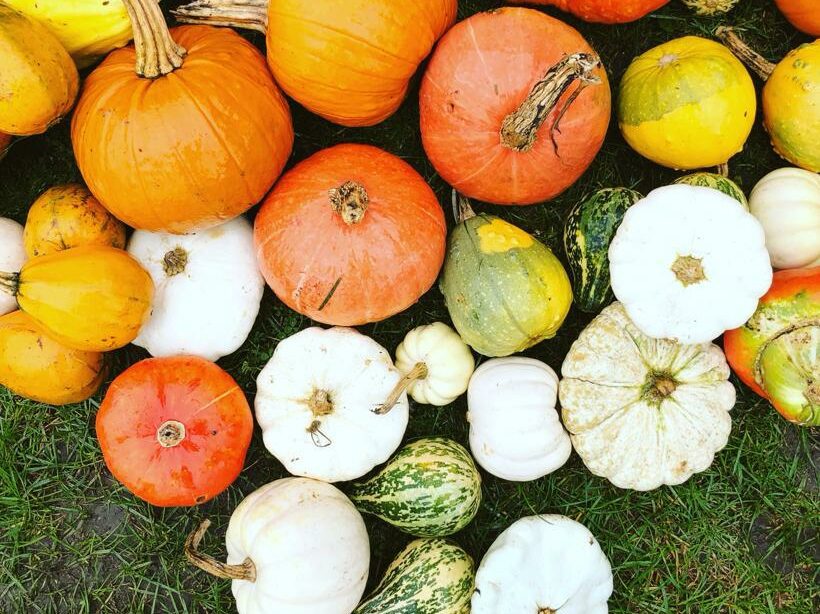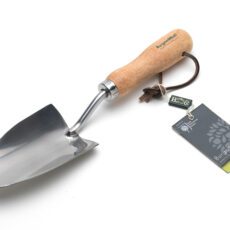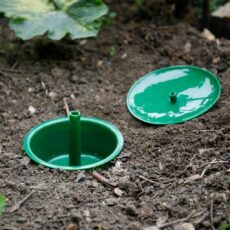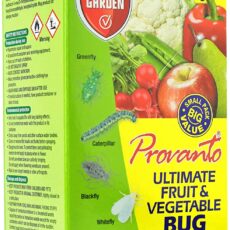Imagine the thrill of harvesting your own pumpkins, ideal for autumnal decorations and delicious seasonal treats, right from your garden. Growing pumpkins can be a truly rewarding venture, bringing a touch of seasonal magic to your outdoor space. Whether you’re an experienced gardener or just starting out, our comprehensive guide will take you through every step of the process—from selecting the best variety to nurturing your pumpkins to perfect ripeness.
Get ready to transform your garden into a pumpkin paradise and delight your friends and family with your homegrown produce!
Table of Contents
Pumpkin Fact File
Discover the essentials of growing and using pumpkins with our quick fact file. From their ancient origins in North America to the expected height and spread you can expect to see from your plants, this overview will provide you with the key generalised details of this versatile vegetable.
- Genus Name: Cucurbita
- Family: Cucurbitaceae (Gourd family)
- Origin: Native to North America (Mexico, dating back to somewhere between 7000 – 5550 B.C.)
- Plant Type: Annual vine
- Growth Habit: Spreading or climbing
- Height: 30-60 cm (12-24 inches) on average
- Spread: 1-3 metres (3-10 feet)
- Flowering Season: Summer to early autumn
- Harvest Time: Late summer to early autumn, usually 75-100 days after sowing
Pumpkin Seed to Fruit
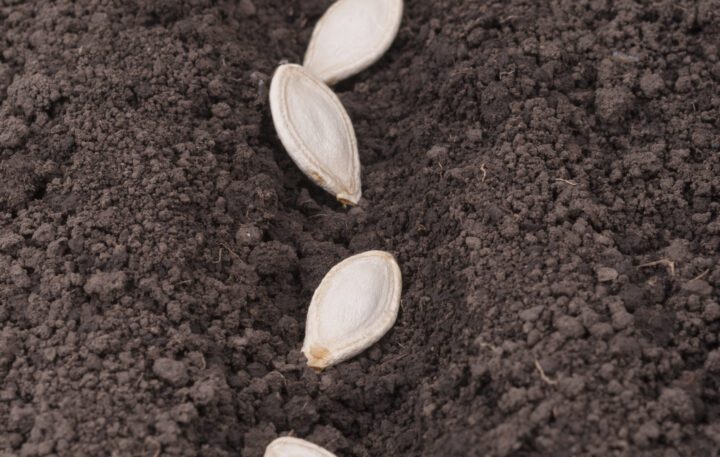

Whether you’re planning your garden or preparing a seasonal dish, you’ll first need to start by germinating the seeds of the pumpkin. To get started with the germination process, after selecting your variety start by determining if you’re sowing indoors, or directly outdoors. You’ll first need to prepare your seeds.
To prepare your pumpkin seeds for planting soak them in water for about 24 hours before to help kickstart the germination process.
Sowing Pumpkin Seeds Indoors
Start sowing your pumpkin seeds indoors in April or May. Choose a well-draining seed tray or small pots filled with a seed compost mix. Sow the seeds about 2.5 cm (1 inch) deep, spacing them 10 cm (4 inches) apart. Keep the compost moist but not waterlogged and place the tray or pots in a warm, sunny spot with temperatures around 21-24°C (70-75°F).
Germination usually takes 7-10 days.
Indoor sown plants should be hardened off by the end of May to give them a chance to adapt to the outside environment. To help them acclimatise, move them into a greenhouse or cold frame for 6-8 days.
Once the seedlings have grown to about 5-10 cm (2-4 inches) tall and have a couple of true leaves, they can be transplanted into larger pots or directly into the garden, typically in late May or early June, when the risk of frost has passed.
Did you know?
True leaves appear after the initial seed leaves (cotyledons) and can be easily identified as they resemble the shape of the mature plant’s foliage. Keep an eye out for these leaves as a sign your pumpkin plant is starting to develop.
Sowing Pumpkin Seeds Outdoors
If you prefer to sow your pumpkin seeds directly outdoors, wait until the risk of frost has passed and the soil has warmed up – typically late May to early June in the UK.
Choose a sunny, sheltered spot with well-drained, fertile soil. Pumpkins need plenty of space to spread, so allow around 1-2 metres (3-6 feet) between each seed, depending on the variety.
To sow, create small mounds or ridges in the soil about 2.5 cm (1 inch) deep, as this helps with drainage and encourages strong root development. Place 2-3 seeds in each mound, spaced a few centimetres apart. Water the area well after sowing and keep the soil consistently moist but not waterlogged.
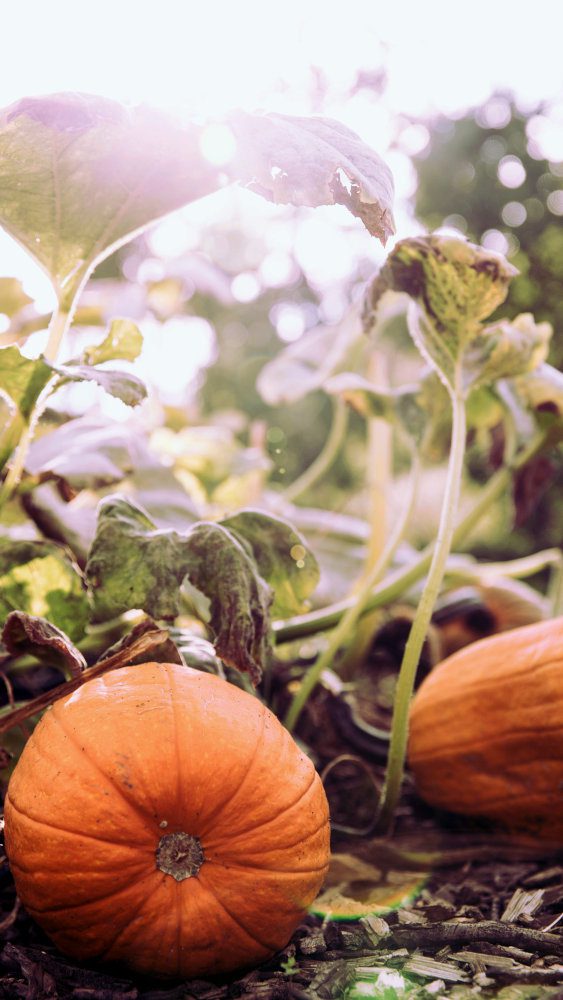
Once the seedlings emerge (usually within 7-10 days), thin them out, leaving the strongest plant in each mound.
If you have a seed packet, always refer to it for specific guidance on your chosen variety.
Keep the area free of weeds and continue to water regularly, especially during dry periods, to support healthy growth.
If you need some further advice explore our top ten tips for growing seeds to help you grow success!
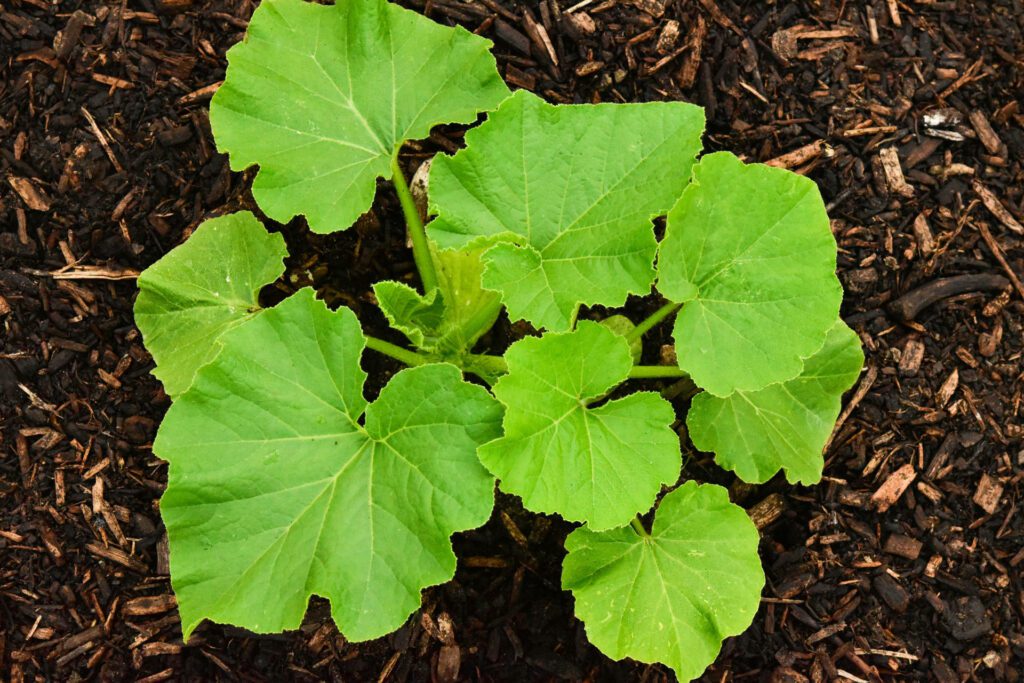
Growing and Maintaining Your Pumpkin Plants
Pumpkins thrive when planted in a sunny, sheltered spot, as they need warmth and plenty of sunlight to grow to their full potential. Choose a location that receives at least six hours of direct sunlight each day, and ensure the soil is rich, well-drained, and consistently moist.
Protecting the plants from strong winds is also important, as their large leaves and sprawling vines can be easily damaged. Adding organic matter or compost to the soil before planting will give your pumpkins the nutrients they need for vigorous growth.
To manage the plant’s spread and encourage larger fruits, consider pruning the vines. Once the vine has developed a few fruits, pinch off the growing tips to stop further vine growth and direct the plant’s energy into ripening the existing pumpkins. Remove any side shoots that are not producing fruit to reduce overcrowding and improve air circulation. This practice helps to control the size of the plant and can result in better-quality pumpkins.
Watering Your Pumpkin Plant
Pumpkins are thirsty plants, especially as they begin to develop fruit, so regular and consistent watering is essential. Aim to water deeply, ensuring the moisture reaches the roots. It’s best to water early in the morning or late in the afternoon to prevent excessive evaporation during the heat of the day.
Avoid overhead watering, as wetting the leaves can encourage fungal diseases. Instead, focus on watering the base of the plant.

To prevent water pooling around the neck of the plant, which can lead to rot, create a small moat or basin around the base to help direct water toward the roots. Pumpkins benefit from a slow, steady release of water rather than quick, heavy soaking, which can cause soil compaction or waterlogging.
During hot, dry spells, pumpkins may require watering up to twice a day, especially if you notice the leaves wilting in the afternoon heat. However, be mindful not to let the soil become waterlogged, as this can suffocate the roots and lead to root rot.
Mulching around the base of the plants with organic matter, such as straw or compost, can help retain soil moisture, regulate soil temperature, and reduce the need for frequent watering. This also keeps the pumpkins clean by preventing soil from splashing onto the fruit during watering or rain.
Hillier Top Tip:
When planting your pumpkins, try using a homemade olla for efficient, slow-release watering. Dig a hole near your plant large enough to bury an unglazed ceramic pot. Seal the drainage hole at the bottom with putty or a small amount of cement, allowing it to cure.
Bury the pot in the soil, leaving the top exposed, and fill it with water. For extra efficiency, cover the top of the olla with the pot’s base or a small plate to help reduce evaporation. The porous clay will gradually release moisture directly to the roots, keeping your pumpkin plants hydrated throughout their growing period. Simply refill the olla as needed for consistent watering.
Feeding Your Pumpkin Plant
To ensure robust growth and a bountiful pumpkin harvest, regular feeding is crucial. Pumpkins are heavy feeders and require a balanced approach to fertilisation throughout their growing season.
Start by enriching the soil with organic matter or compost before planting. This provides a solid foundation of nutrients and improves soil structure. Once your pumpkin plants are established and start to flower, switch to a high-potassium liquid fertiliser to support fruit development. Potassium is essential for strong cell walls, disease resistance, and overall fruit quality.
Feeding Schedule:
- Initial Growth (Pre-flowering): Use a balanced fertiliser with equal parts nitrogen, phosphorus, and potassium, or a general-purpose vegetable feed. Apply every 4 – 6 weeks to support vigorous leaf and vine growth.
- Flowering and Fruit Development: Transition to a high-potassium fertiliser, such as a tomato feed or a specialised fruit fertiliser. Apply every 10 – 14 days, following the manufacturer’s instructions. This helps to promote healthy fruit set and enhances the size and sweetness of the pumpkins.
Application Tips:
- Water the plants thoroughly before applying fertiliser to prevent root burn.
- Apply the fertiliser evenly around the base of the plant, avoiding direct contact with the stems and leaves to reduce the risk of burn.
- Ensure the soil remains consistently moist but not waterlogged, as this aids in the uptake of nutrients.
By following a consistent feeding routine and using the right types of fertilisers at the appropriate stages, you’ll encourage vigorous plant growth and maximise your pumpkin yield.
Hillier Top Tip:
For optimal pumpkin growth, consider using a seaweed-based fertiliser once a month. Seaweed fertilisers are rich in trace elements and growth hormones that promote root development and overall plant health. They can be a beneficial supplement to your regular feeding schedule, especially in nutrient-poor soils.

Protecting Your Pumpkins from Pests and Diseases
Pumpkins are generally resilient plants, but they can still fall victim to common pests and diseases if not properly cared for. Protecting your plants throughout the growing season is key to ensuring a healthy and abundant harvest. Here are some tips to help you keep your pumpkin plants safe:
Common Pumpkin Pests
- Aphids: These small, soft-bodied insects cluster on the undersides of leaves and feed on plant sap. This can stunt growth and attract other pests.
- Solution: Regularly inspect the plants and wash off aphids with a strong jet of water. Introducing natural predators like ladybirds can also help control aphid populations.
- Slugs and Snails: These pests tend to target young seedlings and can cause severe damage by eating leaves and stems.
- Solution: Use organic slug pellets or set up physical barriers like crushed eggshells or copper tape around your plants. You can also try trapping slugs with a shallow dish of beer placed near the plants.
- Cabbage White Butterflies (Caterpillars): While primarily a threat to brassicas, these butterflies occasionally lay eggs on pumpkin plants, and their caterpillars can feed on the foliage.
- Solution: Netting your plants can prevent butterflies from laying eggs, or you can remove caterpillars by hand.
- Vine Weevils: These pests are more common in container-grown plants, feeding on the roots and causing the plant to wilt.
- Solution: Use biological controls like nematodes, which are a natural predator of vine weevils, to protect your plants without the need for chemical treatments.
Common Pumpkin Diseases
- Powdery Mildew: This fungal disease is common in the UK and causes a white, powdery coating on leaves. It can weaken the plant and reduce fruit production.
- Solution: Ensure good airflow by spacing plants adequately, and avoid overhead watering. If needed, apply an organic fungicide or a homemade remedy like a mix of baking soda and water to affected areas.
- Downy Mildew: This fungal disease shows up as yellow patches on leaves, eventually causing them to brown and die.
- Solution: Keep the area around your plants clear of debris and avoid splashing water onto the leaves. Remove affected leaves immediately, and consider using a fungicide designed to combat downy mildew.
- Blossom End Rot: This condition causes the bottoms of pumpkins to rot, often linked to inconsistent watering or calcium deficiency in the soil.
- Solution: Maintain consistent soil moisture by mulching around the base of the plant to retain water. If your soil is low in calcium, consider adding lime or using a calcium-rich fertiliser to prevent this issue.
- Bacterial Soft Rot: This disease typically affects pumpkins after they’ve been damaged, usually through cuts or bruises, causing soft, mushy spots to develop.
- Solution: Handle pumpkins carefully when growing and harvesting to avoid damage. Ensure proper air circulation and remove any rotting fruit to prevent spread.
General Prevention Tips
- Rotate Crops: Avoid planting pumpkins or other members of the cucurbit family (such as courgettes and cucumbers) in the same location year after year to reduce the risk of soil-borne diseases.
- Companion Planting: Marigolds and nasturtiums can help repel pests, acting as natural deterrents when planted near your pumpkins.
- Watering Practices: Water at the base of the plant, rather than the leaves, to reduce the risk of fungal diseases like mildew. Morning watering is best, allowing the soil to dry slightly by evening.
By keeping a close watch for early signs of pests and diseases and adopting these preventative measures, you’ll ensure your pumpkin plants grow healthy and strong, resulting in a successful harvest.
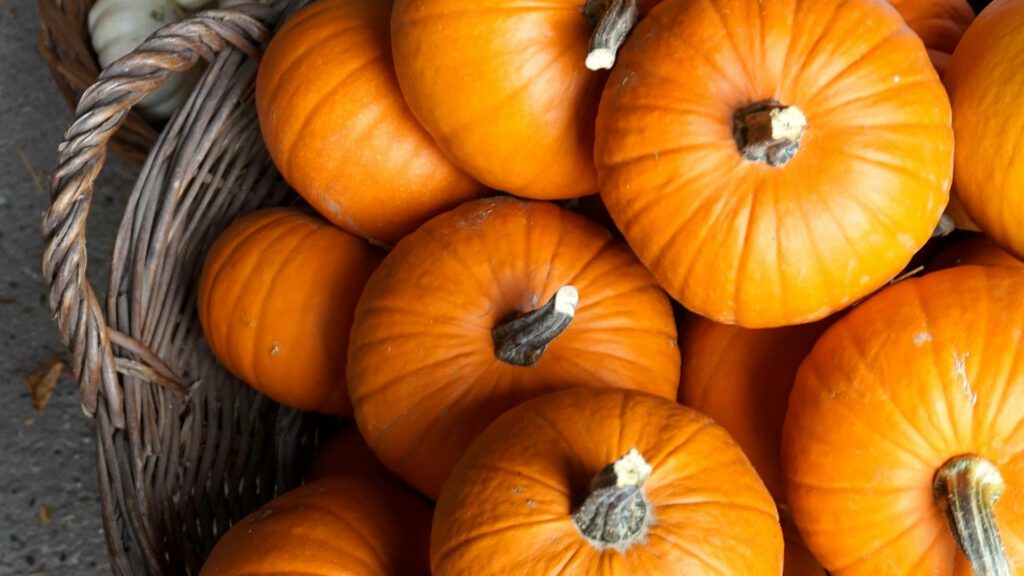
When and How to Harvest Your Pumpkins
Harvest your pumpkins in late summer to early autumn, ideally from September to October.
Timing is crucial: pick your pumpkins before the first frost arrives and ensure they have reached their full colour and firmness. To check if they are ready, press your fingernail into the skin – if it’s difficult to penetrate, the pumpkin is likely mature.
For optimal storage, handle pumpkins carefully to avoid bruising. Use a sharp knife or garden shears to cut the pumpkins from the vine, leaving a few inches of stem attached. Avoid cutting too close to the pumpkin to prevent rot.
After harvesting, cure your pumpkins by placing them in a warm, dry location with good air circulation for about 10 – 14 days. This process helps to harden the skin and improve their storage life. Once cured, store the pumpkins in a cool, dry place, ideally at temperatures between 10 – 15°C (50-60°F). Properly stored, they can last several months, making them a great addition to your winter meals and decorations.
Looking to see what else you can do in the garden in October? Check out our October grow your own guide and get growing this Autumn!
What Can You Use Pumpkins For?
Pumpkins are more than just a seasonal staple—they’re a wonderfully versatile ingredient and decorative element throughout the year. Whether you’re looking to enhance your cooking, add a touch of autumn to your home, or explore new uses for your pumpkin harvest, there’s much more to pumpkins than meets the eye. Discover how pumpkins can be utilised in a variety of ways, including:
Let’s explore each section to find inspiration and make the most of this delightful vegetable.
Cooking and Baking with Pumpkins
Pumpkins are incredibly versatile in the kitchen, lending themselves to both sweet and savoury dishes. From hearty mains to indulgent desserts, there are countless ways to incorporate pumpkins into your meals. Here are some popular ideas:

Pumpkin Pie
A classic favourite, pumpkin pie is rich, creamy, and perfectly spiced. Made with pumpkin puree, eggs, and warm spices like cinnamon, nutmeg, and cloves, this dessert is ideal for those cosy autumn evenings.
While pumpkin pie is often associated with North America, it’s gained popularity in the UK for its smooth, custard-like texture and fragrant aroma.
Serve with whipped cream for a delicious seasonal treat.
Roasted Pumpkin Seeds
Don’t discard the seeds after carving your pumpkin for Halloween!
Roasted pumpkin seeds make for a healthy, crunchy snack. Simply rinse and dry the seeds, toss them in olive oil, and sprinkle with your favourite seasonings—salt, paprika, or even chilli powder for a kick. Roast in the oven at 180°C (350°F) for about 15 – 20 minutes until golden and crispy.
Pumpkin seeds are a great source of fibre, protein, and healthy fats.
Pumpkin Soup
Pumpkin makes an excellent base for a velvety smooth soup. Combine roasted pumpkin with onions, garlic, and vegetable stock for a warming autumn soup. Blend until creamy and season with salt, pepper, and a touch of nutmeg.
Serve with crusty bread for a comforting meal on cooler days.
Pumpkin Lattes
Pumpkin lattes have become a seasonal favourite in cafés, but you can easily make them at home!
Brew your preferred coffee and mix in a pumpkin spice syrup made from pumpkin puree, milk, sugar, and a blend of spices like cinnamon and ginger. Top with frothed milk and a sprinkle of cinnamon for that café-style indulgence.
This cosy drink is perfect for the colder months and can be enjoyed as a morning pick-me-up or an afternoon treat.
Pumpkin Bread and Muffins
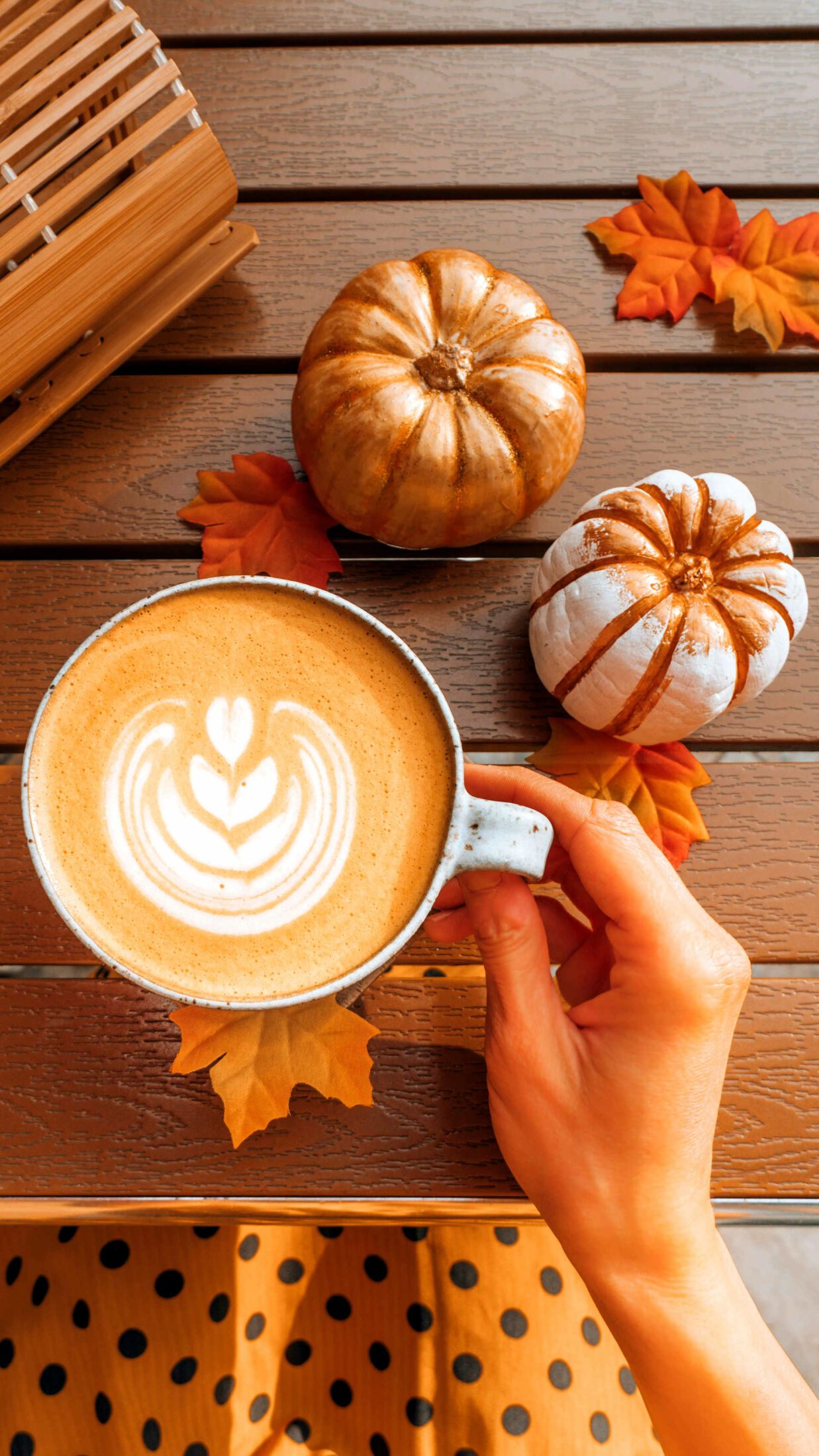
Pumpkin puree is a wonderful addition to bread and muffin recipes, giving baked goods a moist texture and a subtle sweetness.
Combine the puree with flour, sugar, eggs, and warming spices like ginger, cinnamon, and allspice to create fragrant pumpkin bread or muffins.
These make for a lovely autumn breakfast or snack.
Savoury Pumpkin Dishes
Pumpkin can also be used in savoury dishes.
Roasted pumpkin chunks are a fantastic addition to salads, risottos, or even pasta dishes. You can also stuff small pumpkins with grains, herbs, and cheese for an impressive autumnal main course.
Decorating with Pumpkins
Pumpkins aren’t just for cooking—they’re a charming addition to autumn décor as well. Whether you’re looking to create a cosy, seasonal atmosphere inside your home or bring some festive flair to your garden, pumpkins offer endless possibilities for creative decorations. Here are a few inspiring ideas for using pumpkins to decorate your space:
Classic Carved Pumpkins
One of the most popular ways to use pumpkins in décor is by carving them. Whether you’re opting for a spooky design or something more whimsical, carved pumpkins are a great way to add personality to your home or garden. You can hollow out the pumpkin and use battery-operated candles or LED lights to create a warm, glowing effect in the evenings. If you’re aiming for a longer-lasting decoration, consider using faux pumpkins for a similar effect.
Did you know?
Jack-o’-Lanterns were originally carved from turnips or swedes in the UK, long before pumpkins became the go-to choice. This tradition dates to ancient Celtic times, when people would carve grotesque faces into root vegetables to ward off evil spirits during Samhain, a festival marking the end of the harvest season. It wasn’t until the tradition crossed the Atlantic to America, where pumpkins were more plentiful, that the iconic pumpkin Jack-o’-Lantern became popular.
Painted Pumpkins
If you want to avoid the mess of carving, painting pumpkins is a fun and versatile alternative. You can use acrylic paints to create elegant designs like autumn leaves, polka dots, or stripes, or go bold with metallic paints for a chic, modern look.
For a more rustic feel, you can paint pumpkins with chalk paint in neutral tones, giving them a soft, muted appearance that complements country or farmhouse-style décor.
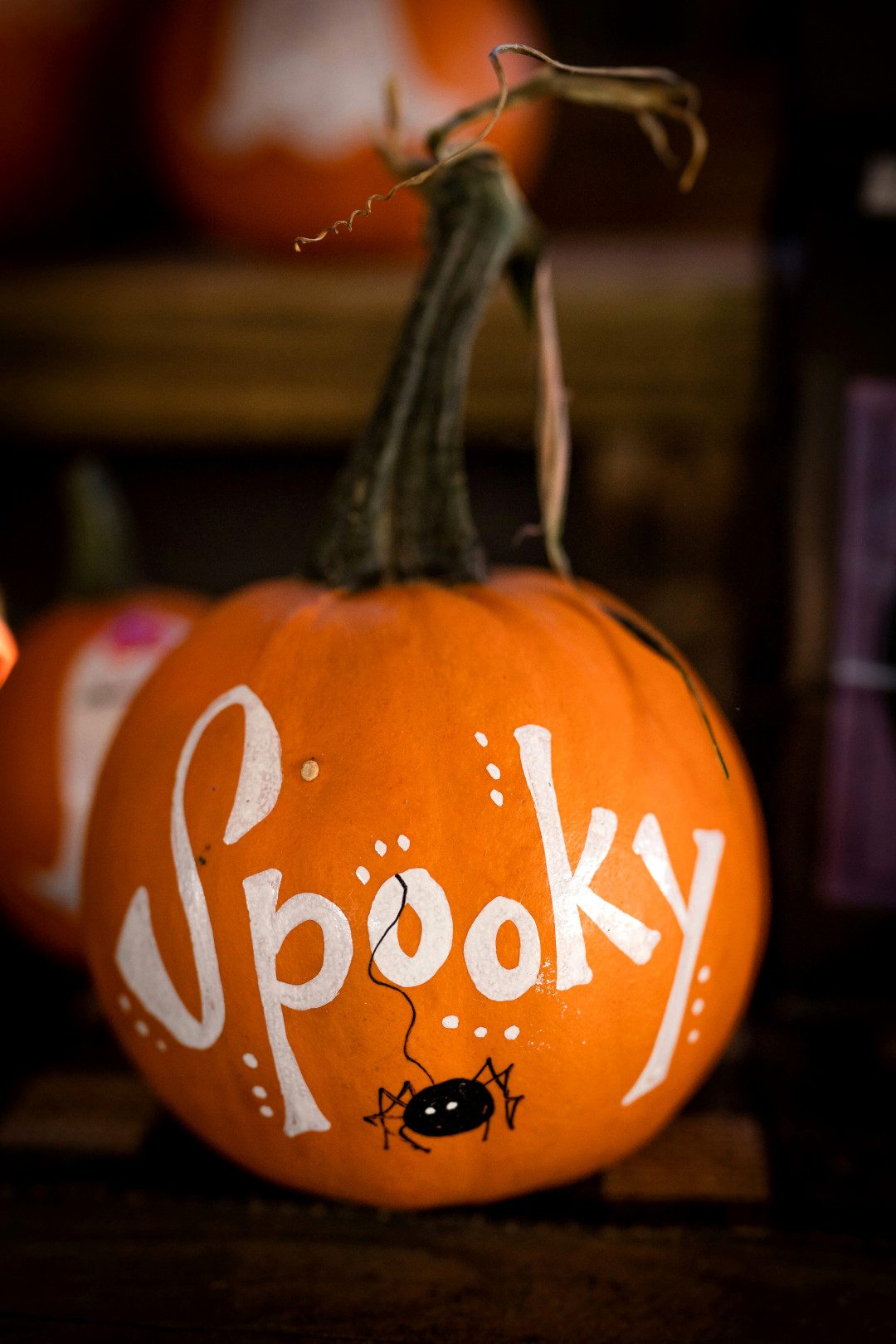
Pumpkin Centrepieces
Pumpkins make for beautiful, natural centrepieces. Hollow out a small pumpkin and use it as a vase to hold seasonal flowers like sunflowers, chrysanthemums, or dried grasses. You can also group several mini pumpkins together with candles and autumn leaves for a stunning table display. These arrangements work well for both indoor dining tables and outdoor entertaining spaces.
Pumpkin Wreaths
Create a festive autumn wreath by incorporating small pumpkins into your design. You can use faux pumpkins in different sizes and colours, combined with twigs, leaves, and berries, to craft a beautiful wreath for your front door.
Not only does it add a welcoming touch, but it also celebrates the seasonal bounty of autumn.
Outdoor Pumpkin Displays
Pumpkins are a staple for outdoor autumn displays. Line your garden path or doorstep with pumpkins of varying sizes and colours to create a festive entrance. For a unique twist, stack smaller pumpkins on top of each other to form a “pumpkin topiary.”
You can also mix pumpkins with hay bales, corn stalks, and lanterns to build a rustic, seasonal scene that celebrates the harvest season.
For a fun alternative to your typical façade, try painting your house number on a pumpkin and leaving it outside your front door.
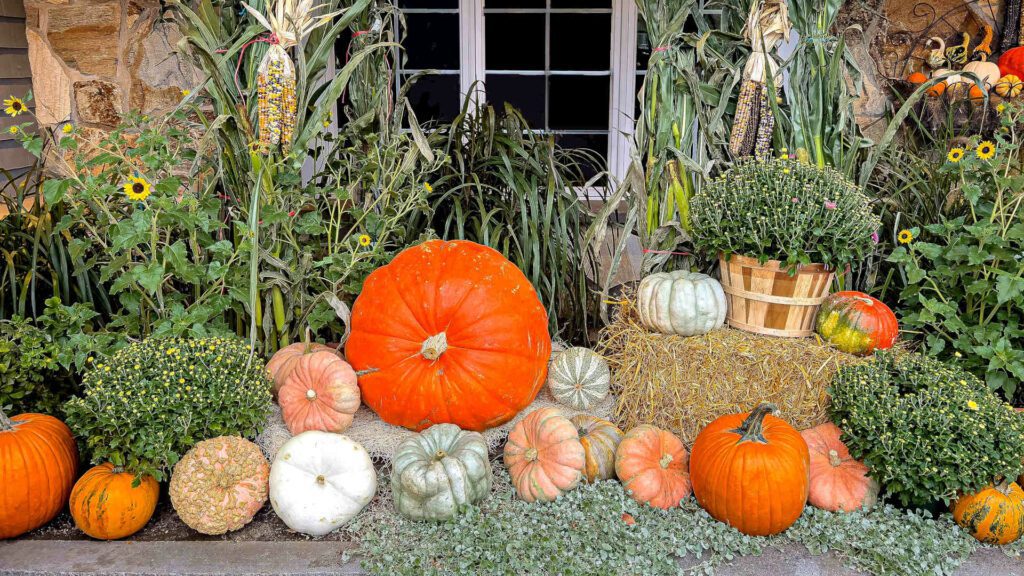
Mini Pumpkin Accents
For a subtle touch of autumn indoors, mini pumpkins are perfect for decorating shelves, windowsills, or mantelpieces. You can mix them with pinecones, acorns, or even fairy lights to create cosy autumn vignettes.
Their compact size makes them versatile for all types of indoor decorating.
From elaborate outdoor displays to elegant indoor arrangements, pumpkins provide endless inspiration for autumn décor.
Whether you’re going for spooky, stylish, or rustic, these versatile vegetables add a seasonal charm to any space.
Health and Beauty Use for Pumpkins
Pumpkins aren’t just for eating or decorating – they also have a variety of health and beauty benefits. Packed with nutrients, pumpkins can improve both your skin and overall well-being.
Here are some health and beauty uses for pumpkins:
Health Benefits of Pumpkins
- Rich in Nutrients: Pumpkins are high in vitamins A, C, and E, which are essential for boosting the immune system, improving vision, and promoting healthy skin. They’re also rich in fibre, which supports digestion and helps maintain a healthy weight.
- Heart Health: The potassium and antioxidants found in pumpkins can help lower blood pressure and reduce the risk of heart disease by maintaining healthy blood vessel function.
- Supports Eye Health: Pumpkins are a great source of beta-carotene, which the body converts into vitamin A. This is vital for maintaining good eyesight and preventing age-related eye conditions like macular degeneration.
- Boosts Immunity: With its high levels of vitamins C and E, pumpkin can help strengthen the immune system, making it easier for the body to fight off colds and other infections.
Beauty Uses for Pumpkins
- Exfoliating Face Mask: The enzymes and alpha hydroxy acids (AHAs) in pumpkins help exfoliate dead skin cells, making them an excellent ingredient for natural face masks. Mixing pumpkin puree with honey and a little yoghurt can create a gentle exfoliant that leaves your skin smooth and glowing.
- Hydrating Treatment: Pumpkin is rich in vitamins and fatty acids that help hydrate the skin, making it perfect for use in face masks or lotions for dry or sensitive skin. The natural oils in pumpkins help restore moisture and keep skin looking plump.
- Anti-Ageing Benefits: The antioxidants in pumpkins, particularly vitamins C and E, help fight the free radicals that cause premature ageing. Regular use of pumpkin-based skincare can help reduce the appearance of wrinkles and fine lines.
- Brightening Face Mask: Thanks to its high vitamin A content, pumpkin can be used to brighten dull skin. Combine pumpkin puree with turmeric and honey for a natural mask that helps lighten hyperpigmentation and evens out skin tone.
- Hair Care: The vitamin E and antioxidants found in pumpkins can also nourish the scalp and promote hair growth. A pumpkin hair mask, made by blending pumpkin puree with coconut oil and honey, can help repair damaged hair, moisturise the scalp, and add shine.
- Nail and Cuticle Care: Pumpkins are packed with biotin, a B-vitamin that supports nail growth. Eating pumpkin regularly can strengthen your nails, and applying a DIY pumpkin oil blend to your cuticles can help keep them hydrated and healthy.
By incorporating pumpkins into your health and beauty routine, you can enjoy a natural, nutrient-rich boost that’s great for your skin, hair, and overall well-being!
Garden Uses for Pumpkins
Pumpkins can be an integral part of your garden in various ways. Whether you’re looking to improve soil health or create a vibrant autumn display, pumpkins offer several practical and decorative uses:
- Compost Enrichment: After harvesting, any leftover pumpkin plants can be added to your compost heap. Their rich organic matter breaks down quickly, helping to improve the quality of your compost for next year’s growing season. Even the pumpkin shells can be composted after use.
- Pollinator Attraction: Pumpkin flowers are large and vibrant, attracting bees and other beneficial pollinators to your garden. These pollinators can help boost the overall health of your garden by encouraging more fruiting in other plants, making pumpkins a valuable addition to a pollinator-friendly garden.
- Autumn Displays: Use your homegrown pumpkins to create seasonal displays in your garden. Arrange pumpkins of different sizes and varieties on your doorstep, along pathways, or around flower beds for an eye-catching autumn scene.

- Ground Cover and Weed Suppression: As pumpkin vines spread, they create a natural ground cover, which helps suppress weed growth. This can reduce the need for weeding in parts of your garden while also keeping the soil cool and moist for longer.
- Soil Improvement: Growing pumpkins can help improve your soil. Their sprawling root system aerates the ground and enhances soil structure. When left to decompose naturally, pumpkin plants contribute organic matter to the soil, enriching it for future planting.
- Scarecrow: By filling some clothes with straw and mounting it to a stake you can carve a Jack-O’-Lantern and use it as the head of a scarecrow to help keep birds off of your allotment.
By incorporating pumpkins into your garden design and maintenance strategy, you can enjoy both their practical benefits and their aesthetic charm throughout the autumn months.

The Overall Benefit of Pumpkins
From the moment you plant your seeds to the delight of harvesting your homegrown pumpkins, the journey of growing these vibrant vegetables is truly rewarding. With their rich history, versatile uses, and undeniable charm, pumpkins are a fantastic addition to any garden. By carefully nurturing your plants, managing pests and diseases, and following best practices for watering and feeding, you can enjoy a bountiful harvest.
Once harvested, pumpkins offer endless possibilities. In the kitchen, they transform into everything from classic pumpkin pie and creamy soups to hearty breads and lattes. Their culinary versatility ensures that you can savour their flavour in a variety of delightful ways.
Beyond the kitchen, pumpkins shine as seasonal decorations, adding warmth and whimsy to your home with carved designs, painted creations, and autumnal centrepieces.
Moreover, pumpkins contribute to health and beauty routines, boasting a wealth of nutrients that support skin, hair, and overall well-being. In the garden, they provide practical benefits, enriching compost, attracting pollinators, and improving soil health.
Whether you’re a seasoned gardener or a novice, integrating pumpkins into your life and garden can bring both joy and practicality. Embrace the seasonal magic of pumpkins and let them inspire creativity and nourishment throughout the year.
Head down to your local Hillier Garden Centre for expert advice and to view our full range of all things pumpkin.
Happy gardening and enjoy all the wonderful ways to use your pumpkins!


